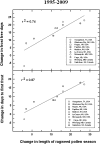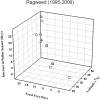Recent warming by latitude associated with increased length of ragweed pollen season in central North America
- PMID: 21368130
- PMCID: PMC3053965
- DOI: 10.1073/pnas.1014107108
Recent warming by latitude associated with increased length of ragweed pollen season in central North America
Abstract
A fundamental aspect of climate change is the potential shifts in flowering phenology and pollen initiation associated with milder winters and warmer seasonal air temperature. Earlier floral anthesis has been suggested, in turn, to have a role in human disease by increasing time of exposure to pollen that causes allergic rhinitis and related asthma. However, earlier floral initiation does not necessarily alter the temporal duration of the pollen season, and, to date, no consistent continental trend in pollen season length has been demonstrated. Here we report that duration of the ragweed (Ambrosia spp.) pollen season has been increasing in recent decades as a function of latitude in North America. Latitudinal effects on increasing season length were associated primarily with a delay in first frost of the fall season and lengthening of the frost free period. Overall, these data indicate a significant increase in the length of the ragweed pollen season by as much as 13-27 d at latitudes above ~44°N since 1995. This is consistent with recent Intergovernmental Panel on Climate Change projections regarding enhanced warming as a function of latitude. If similar warming trends accompany long-term climate change, greater exposure times to seasonal allergens may occur with subsequent effects on public health.
Conflict of interest statement
The authors declare no conflict of interest.
Figures


Comment in
-
The impact of climate change on ragweed pollination.Curr Allergy Asthma Rep. 2011 Oct;11(5):341. doi: 10.1007/s11882-011-0205-8. Curr Allergy Asthma Rep. 2011. PMID: 21720856 No abstract available.
References
-
- Centers for Disease Control and Prevention Allergies and Hayfever. 2005. Available at www.cdc.gov/nchs/fastabs/allergies.htm. Accessed February 3, 2011.
-
- Frenz DA. Interpreting atmospheric pollen counts for use in clinical allergy: allergic symptomology. Ann Allergy Asthma Immunol. 2001;86:150–158. - PubMed
-
- Chapman JA. Aeroallergens of southeastern Missouri. Grana. 1986;25:235–246.
-
- Gergen PJ, Turkeltaub PC, Kovar MG. The prevalence of allergic skin test reactivity to eight common aeroallergens in the U.S. population: results from the second National Health and Nutrition Examination Survey. J Allergy Clin Immunol. 1987;80:669–679. - PubMed
-
- Wodehouse RP. Hayfever Plants. 2nd Ed. New York: Hafner; 1971.
MeSH terms
LinkOut - more resources
Full Text Sources
Miscellaneous

